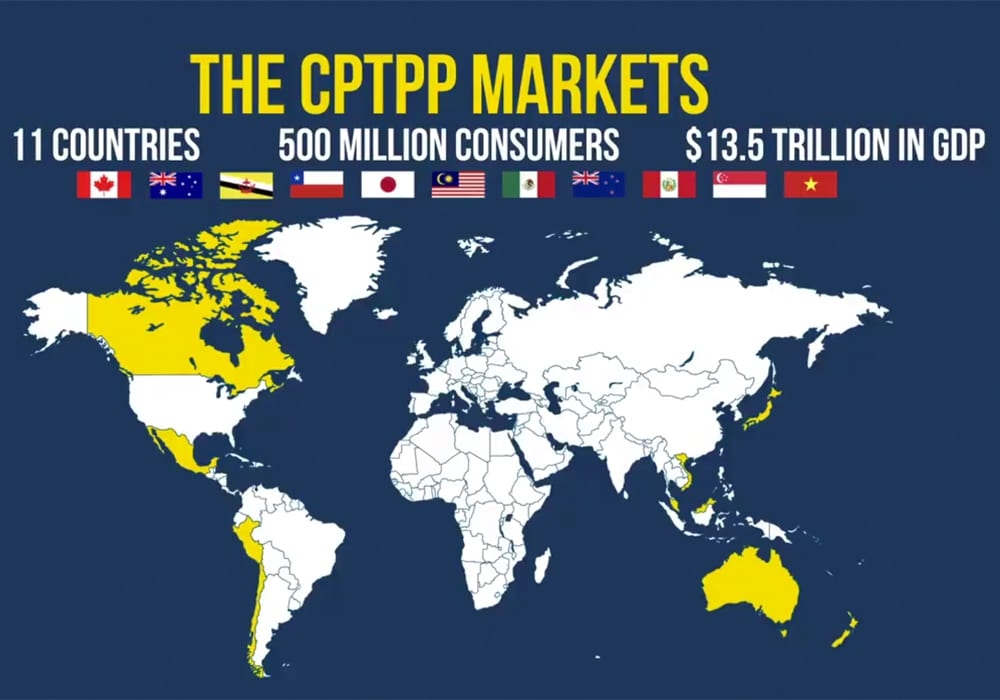Vietnam export performance soars after two years into CPTPP
 |
| Vietnam is one of the winners of the CPTPP |
Exploration of recent trade and investment data during this turbulent time suggests that Vietnam, for which the CPTPP is a flagship trade deal, has seen especially large gains in goods exports and imports as well as investment inflows. The information was revealed in the latest report by Center for Strategic and International Studies (CSIS).
In 2018, 11 countries (Australia, Brunei, Canada, Chile, Japan, Malaysia, Mexico, New Zealand, Peru, Singapore, and Vietnam) came together to sign the CPTPP, hailed at the time as the gold-standard deal that would uphold free trade in the Asia-Pacific region amid the US-China trade war.
In 2019, the first year of the CPTPP’s implementation, members’ trade in the CPTPP region dropped by 4 per cent, with the exceptions of Vietnam (7 per cent growth) and Australia (0.5 per cent export growth), and signatories that had not ratified the deal, Brunei (27 per cent) and Peru (24 per cent).
Vietnam gained in manufactured exports to the CPTPP, especially to Japan. In 2020, amid COVID-19, all CPTPP members’ exports to the bloc declined, though Chile and Vietnam managed to grow their global exports by about 6 per cent, with Vietnam benefiting from global demand for phones, electronics, and computers.
CPTPP members’ intra-bloc export performance mirrors their overall export performance: from 2017 to 2020, the ups and downs of CPTPP members’ trade with each other have followed the patterns of their trade with the rest of the world.
Australia, Brunei, Malaysia, and Vietnam expanded their exports both to CPTPP members and the world during this period, while Canada’s and Japan’s exports to CPTPP members and the world dropped. In general, CPTPP members’ intra-bloc export gains from 2017 to 2020 were nonexistent or lackluster, except for Vietnam (4 per cent export growth into CPTPP per annum) and Brunei (15 per cent growth, albeit from a low base).
Indeed, the CPTPP was built on the extensive network of bilateral and regional trade agreements among member economies. It could be expected to increase the trade flows of partners without extensive trade agreement networks – such as Vietnam, for which the CPTPP represented the first flagship FTA, with deep liberalisation both for outbound and inbound trade.
According to a 2019 World Bank estimate, Vietnam will have gained deep market access to CPTPP members and eliminated tariffs on them by 2030. New Zealand and Singapore will also gain significant new access, Brunei will liberalise, and Japan and Singapore will bring down non-tariff barriers. Brunei and Vietnam are expected to score the greatest GDP growth gains, at 1.9 and 1.1 per cent, respectively, by 2030.
What the stars mean:
★ Poor ★ ★ Promising ★★★ Good ★★★★ Very good ★★★★★ Exceptional
 Tag:
Tag:
Related Contents
Latest News
More News
- Vietnam’s green transition demands collective financial action (December 15, 2025 | 12:00)
- VIR workshop highlights capital and policy for sustainable development (December 15, 2025 | 11:00)
- National Assembly approves pilot mechanisms to accelerate major projects in Hanoi (December 12, 2025 | 11:29)
- Vietnam eases policy approval requirements, simplifies foreign and outbound investments (December 11, 2025 | 17:53)
- Unpacking new momentum in Vietnam’s M&A market (December 10, 2025 | 09:59)
- Forum honours outstanding M&A deals, strategies, and advisory firms (December 09, 2025 | 18:22)
- Vietnam enters defining phase of M&A growth (December 09, 2025 | 17:00)
- Vietnam’s M&A market opens new opportunities amid strong economic momentum (December 09, 2025 | 15:00)
- Vietnam M&A Forum 2025: new position, new momentum (December 09, 2025 | 14:30)
- FDI in Vietnam jumps on additional capital and share purchases (December 09, 2025 | 13:56)
























 Mobile Version
Mobile Version